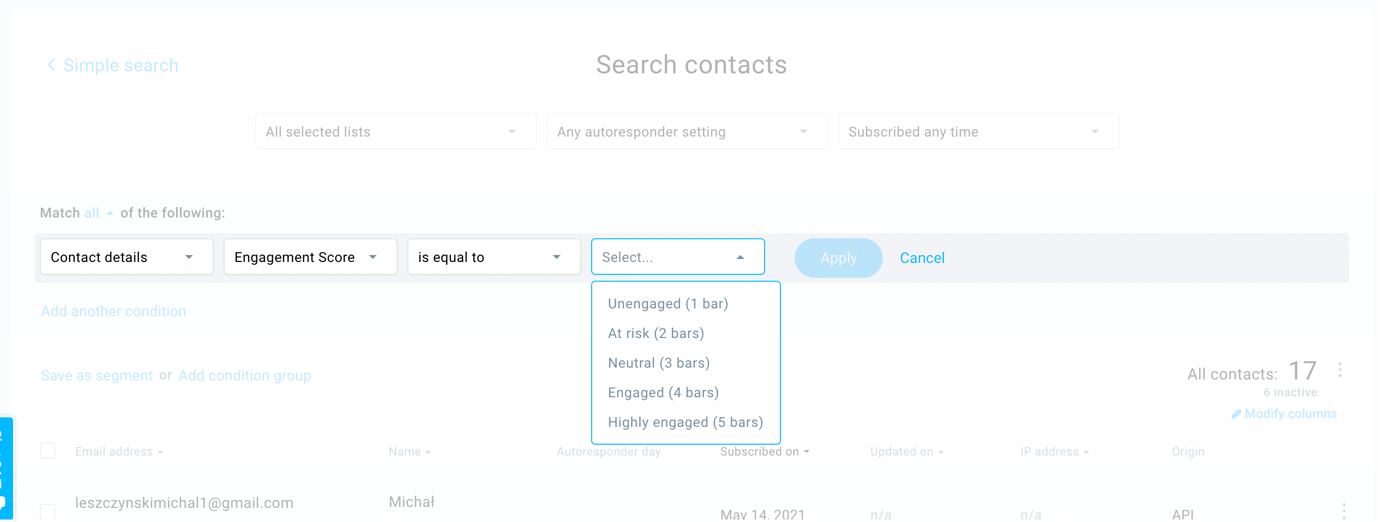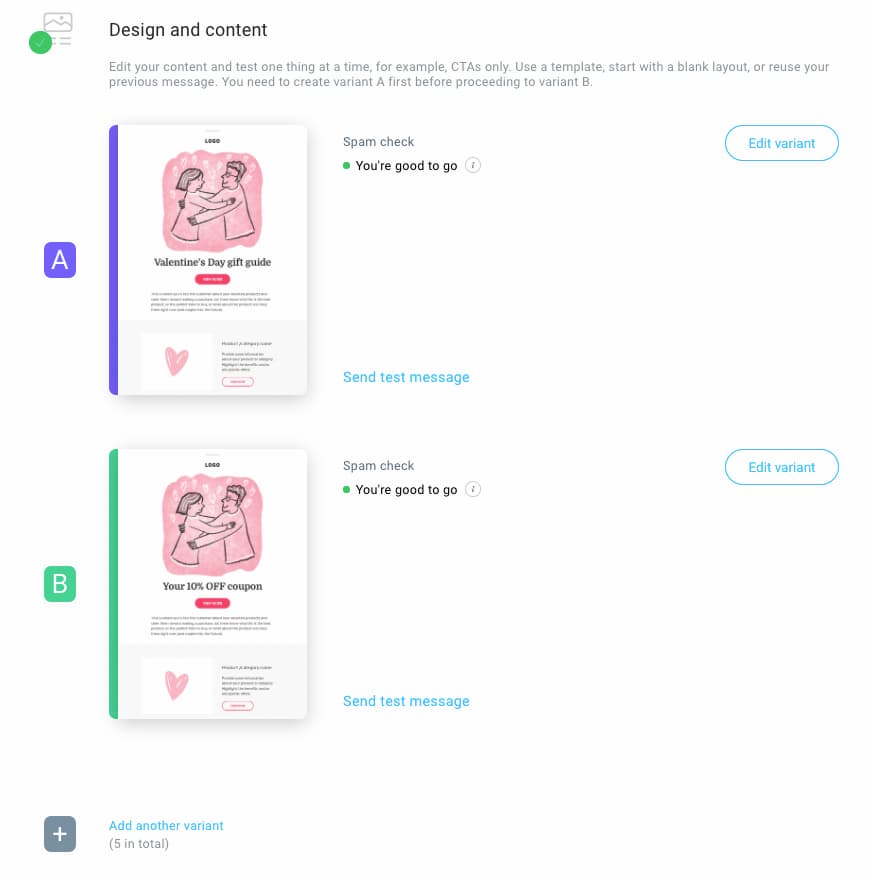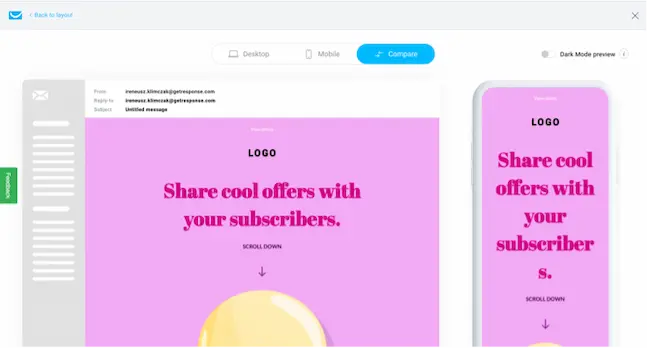One of the leading trends in email marketing nowadays is using more technology across the customer journey. Marketers regularly test various technology solutions to grow their audience, collect valuable information, and create segments that allow for relevant and personal communication with new subscribers, prospects, and customers.
Marketing automation is at the heart of this trend. It allows you to run complex communication flows using multiple communication channels and collect data to build solid subscriber profiles. In this article, I’d like to show 9 advanced email marketing techniques that help you connect with your contacts and improve your email marketing results.
Editor’s note: Don’t worry if you haven’t tried all of the following advanced email marketing techniques. As long as you follow these email marketing best practices, you’re on a good path to achieving great results from your email program.
1. Formulate your email marketing strategy assuming that email is a two-way communication
Back in the day, email marketing was about sending information from your brand to your email list. The process was as follows: you came up with content ideas you wanted to share with your audience, created emails, and sent them to your contacts. You observed the open rate and click-through rate to check if the audience considered your content ideas relevant.
Now, consider email a two-way communication channel. You can integrate customer data points like your website, ecommerce store, and CRM and create segments in order to send personalized messages asking the people on your list direct questions building solid contact profiles.
You can define a few audience personas and send them personalized emails where they can provide answers by clicking a CTA, taking a quiz, filling out a survey, or discussing things via live chat.

If you’re looking for a cost-effective and convenient way to gather data from your audience, here’s the ultimate guide to email surveys: benefits, types, and best practices.
All of this helps you with customer journey mapping and grouping contacts into segments sharing key goals at each stage of the buying cycle. You can A/B test email communication so that they receive the information they need in order to make a purchase decision.
If you’re new to email marketing, you might want to start with Email Marketing for Beginners.
2. Plan email marketing campaigns with marketing automation
If you aim for long-term success, you need tools that allow you to make data-based decisions. And that’s why you need marketing automation. It allows you to plan email marketing communication from top to bottom.
You can start by focusing on the big picture, like your main business goals at the key stages of the customer decision journey. Then you can identify customer information needs and plan relevant content – the information your contact needs in order to make a decision to purchase your product.
When you’ve mapped out your buyer’s journey and identified the right kind of content, you can use conditions, actions, and filters to create workflows (sequences of messages and actions for your online marketing communication).
You can start by automating simple campaigns, such as welcome emails, promotional campaigns, and reminders, and then gradually move toward complex ideas, such as acquisition campaigns, content marketing campaigns, and loyalty programs.

Automation helps you collect data, monitor the performance and optimize the communication processes. You can make changes to parts of individual campaigns or reevaluate the entire customer decision journey. Read more on Small Business Email Marketing Strategies to Grow in 2025
If you want to explore the topic of marketing automation for advanced email marketing strategies, here’s a comprehensive guide: What is Email Automation & Why Use It? (+30 Awesome Automated Email Responses)
3. Collect contact details through progressive profiling
In 2025, it’s finally time to go beyond personalizing with the subscriber’s first name. Think of personalization as a strategy for building long-lasting relationships with the people on your mailing list. To do that, you need to engage and provide value to your audience all along the buyer’s journey. But how do you know what they want?
Try progressive profiling — collecting information about each customer‘s interests by observing their behavior, e.g., emails they open, links they click, websites they visit, and product categories they research. Then use the data to create segments that allow you to personalize messages and keep your audience engaged.
There are two kinds of progressive profiling:
Direct profiling – asking direct questions via webforms, landing pages, chats, or email templates where you can provide CTA buttons with possible answers and update readers profile when they choose and click one.


Indirect profiling – creating categories in the email. When the reader clicks a category, the information is used to record their interest.

To get to know your subscribers, focus on these areas when personalizing email campaigns.
Design content your audience finds valuable
Make sure you know the reasons why people sign up for your list. What sort of information do they need to make a purchase? Only after you discover your audience’s needs and wants will you be able to personalize your emails.
Remember: new subscribers needs change as they move through the buyer’s journey. Recognize and address various needs across the customer lifecycle to provide value.
Bundle relevant offers
Analyze subscriber activity and select the products they consider most interesting. Strategically bundle products and drive traffic to products solving specific problems of relevant segments.
Recognizing your audience preferences and sending targeted offers improve user experience and result in more sales. It makes it easier to create complementary offers and run successful cross-sell and up-sell campaigns.
Test frequency
Why is email frequency important? If you send too many emails, you’ll see high unsubscribe rates. If you send too few, people may forget they signed up and you may not produce the desired results.
So how can you determine the right frequency? The best way is to ask your target audience directly and test the results. You can create a simple automation workflow: create an email with two call to action buttons and move your audience to separate campaigns based on the one they click.
4. Personalize email campaigns through advanced segmentation
Did you know that the average open rate for emails sent using automation is 35.33%, and the average click-through rate is 3.69%? One of the reasons behind such high results is the fact that marketers who use automation very often segment their lists and create workflows for carefully selected groups of contacts.
Segmentation can be based on all types of data, including:
- Demographic (gender, location, job title)
- Derived (predicting subscriber behavior, customer value)
- Behavioral (purchases, opens, clicks, website browsing, etc.)
Read also: Behavioral segmentation and strategies
If you use a professional email marketing system that supports marketing automation and dynamic content, you can use the data you collect to run highly targeted campaigns aimed at various customer personas.

Want to learn what is email segmentation and how you can use it? Check out our video, where we teach you how to use email segmentation.
For GetResponse users, here’s how you can personalize your website’s shopping experience and email campaigns with automated, AI-driven product recommendations.
Lead Scoring
Scoring is one of the techniques that help integrate marketing and sales efforts. It allows you to track and rate subscriber actions. With lead scoring, you can:
- Add or subtract points based on user behavior (opens, clicks, downloads)
- Use individual customer scores to build personalized marketing automation workflows that are score-driven.
- Build reward programs for your most valuable customers.
- Build early warning systems to help you identify declining customer loyalty or engagement.
- Reset customer scores at any time to start over.
The most important step in segmentation is deciding on the information you need in order to run a successful email marketing program. There is so much data available that it’s easy to get overwhelmed and stuck in analysis paralysis. Be precise and focus only on the actionable data that will impact the quality of your communication.
5. Provide contacts with a seamless experience through omnichannel
There are a lot of great tools that help you run your business. Whether you are an SMB or an enterprise, you’ll find the right tech stack to meet your business needs — from behavior tracking to customer relationship management and content management to e-commerce platforms — you name it.
Integrating email marketing with other tools for new capabilities
By integrating various tools with distinctive sets of features, you create a comprehensive platform with a powerful mix of capabilities. For example, you can combine email marketing with webinars to gain a powerful list building, lead generation, and sales tool. If you combine email marketing, webinars, and automation, you’ll be able to make data-driven decisions about your online marketing communication.

All the marketing tools you use are sources of valuable data about subscribers, prospects, and customers. You can use the data to segment subscribers on your list, profile prospects, and target them with relevant email marketing campaigns.
For example, as an email marketer with the right data set, you can go beyond opens or clicks and aggregate information from various sources, (website, landing pages, CRM). By looking at the whole customer experience rather than individual marketing channels, you will be able to see what makes people engage in communication with your brand or identify what has the biggest impact on sales.

See how the team at Biznes Boxing Polska saves time and increases revenue by automating SMS and email communication for white collar charity boxing galas.
Want to make more impact with your SMS campaigns? Take a look at these 7 SMS marketing automation campaign ideas and learn how to set them up all by yourself.
6. Verifying ideas with A/B testing
Another advanced email marketing technique that’s become huge in 2025 is A/B testing. Of course email marketers have been testing subject lines and email templates for a long time, but now it’s about making testing a pillar of your team culture.
Invite team members to come up with different hypotheses and run tests in order to see whether they are true or false. This way you’ll learn a lot about your audience, your products, and your marketing operations. And putting learning at the center of your organization is a huge leap towards satisfaction and innovation.

You can choose up to 5 variants for testing in GetResponse.
The team at Mobile Fun, one of GetResponse customers, automates processes, segments contact lists, and runs A/B tests to deliver targeted newsletters to their audience around the world. One of their A/B test had the following results:
- Variant A test open rate: 11.69%
- Variant B test open rate: 12.37%
- Winning campaign open rate: 49.17%
“With GetResponse you can actually check what is driving your KPIs. We’re doing around 20 split tests at the moment. We’re testing how different colors, background images, CTAs impact sales and revenue.” – Matt Page, Email Marketing Executive at Mobile Fun.
Read the GetResponse | Mobile Fun case study to learn how to test marketing emails.
7. Using paid ads for contact list building
Email marketing is one of the owned media channels with your contact list being among your most precious business assets. When it comes to list building, the idea is simple – be where your target audience is and invite them to join you email list. To vast majority of businesses, it means social media.
Facebook and Instagram became huge platforms for brand awareness. However, the organic reach has been dropping significantly. That’s why you need to turn to paid ads if you want to get your offer in front of your audience. The cool thing is that you can use the data to define your target audience and if you have at least 500 contacts on your list (ideally satisfied customers), you can use lookalike audience and rely on algorithm to find people with similar characteristics. This way you can build a solid email list much faster.
Of course, you should monitor the ROI and run experiments in order to make the most of your paid ads budget. If you want to build an email list from scratch, here are few email list building ideas to try.

Did you know that with Google Ad Audiences, you can sync your contacts with your ad account to include/exclude/observe how your contacts respond to your ads? Read more in the feature update: how to create Google ads in GetResponse.
8. Designing emails for dark mode
With new email clients supporting dark mode, it’s becoming more and more popular.
- Light text on a dark background is easier on the eyes., especially in low-light situations.
- Some people prefer the dark mode easthetics and pay more attention to content presented in such a way
- It saves your battery life, by reducing screen brightness.
That’s why you should check you email templates for both bright and dark interfaces.


Want your email campaigns to shine and get your audience clicking? Then read our Email Design Best Practices for 2025
9. Enhancing advanced email marketing strategies with AI tools
2024 showed us that almost every aspect of marketing can be optimized, improved, and sped up with Artificial Intelligence. Email service providers quickly adapted to the new reality and started using the power of AI to help users create better performing email campaigns faster.
For example, GetResponse AI email generator allows you to create emails in 3 simple steps:
- picking topic
- setting tone
- choosing a design

As you can learn from our recent webinar, using AI can help you create engaging email campaigns at a fraction of the time.
Here’s more content on the AI tools you can use in your advanced email marketing strategies:
- New GetResponse features: AI Subject Line Generator and AI Email Generator
- 5 smart ways to use AI in email marketing to save time & money
What’s next
These advanced techniques will help your email campaigns shine. But when you do sit down to plan out and design your email program, you shouldn’t forget about the general rules of email marketing and what makes people click. The following articles will help you ensure you don’t make any mistakes that could affect your email deliverability and conversion rates.
Recommended reading:
